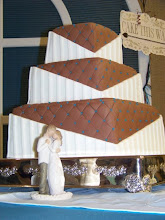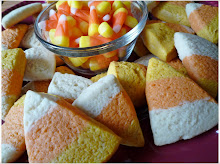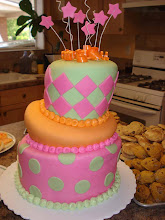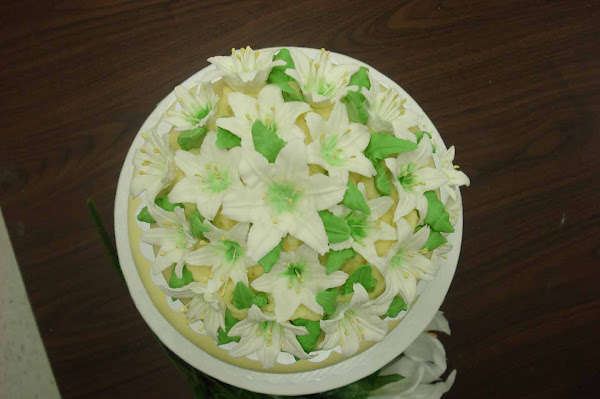I think so! And I'm not the one addicted.
My daughter just finished her Science Fair Project, and she did it on the accuracy of measuring when making bread. She had several people scoop a cup of flour. She determined that even though the same measuring cup was used, the amount was not always the same (due to packing or not packing, leveling or not leveling). Give or take about 6%.
She ended up making 3 batches of bread. But instead of measuring the flour with a cup, she weighed it in grams. Her first batch had the right amount of flour. Her second batch had 6% too little flour. And her third batch had 6% too much flour.
Next she had people taste the bread to determine if they could tell which one had the right amount of flour. The tasters liked all three, but the one with the exact amount of flour won the game. Good job Erin for a project well done!
My husband has really taken a liking to Erin's bread. The project was due last week, and he has made 3 or 4 batches of bread since then. So, as you can see, he is the addicted one......and it is WONDERFUL!
My house smells so good. Simplicity is the key. This bread recipe is very easy to make, and it tastes great. The crust is nice and crunchy, and the inside is so soft that it melts in your mouth. Did you know it only has 4 ingredients? Yeah, I was surprised too. Here is the recipe.....
1000 grams bread flour
20 grams salt
14 grams dry activated Yeast
600 grams of water
That's it! That's all you need. Now, grab a bowl and get ready to make this wonderful bread.
1. Place all of the dry ingredients in a large bowl and give them a dry mix with a spoon.
2. Make a well in the center and pour in the water.
3. Gradually stir the flour into the water until it is all incorporated. Flour can vary or even humidity can make a difference so you might find you need to add a little more flour or water to produce a workable dough. You don't want it too sticky or to tough to work with.
4. It's time to get your hands dirty. Turn your dough out onto a floured surface. A board or even just your table top is fine. Start kneading the dough. Feel free to stretch, pull or punch the dough in all directions. Then roll it back up and stretch, pull or punch again. Any technique you choose will be fine, just keep working the dough for about 10 minutes until it is even in texture. Now roll the dough into a ball and place it into a lightly greased container that can be covered. You can use your mixing bowl if it has enough room for the dough to double in size, or use a large plastic container or even a bucket. Cover with a lid, plastic wrap or a damp towel.
2. Make a well in the center and pour in the water.
3. Gradually stir the flour into the water until it is all incorporated. Flour can vary or even humidity can make a difference so you might find you need to add a little more flour or water to produce a workable dough. You don't want it too sticky or to tough to work with.
4. It's time to get your hands dirty. Turn your dough out onto a floured surface. A board or even just your table top is fine. Start kneading the dough. Feel free to stretch, pull or punch the dough in all directions. Then roll it back up and stretch, pull or punch again. Any technique you choose will be fine, just keep working the dough for about 10 minutes until it is even in texture. Now roll the dough into a ball and place it into a lightly greased container that can be covered. You can use your mixing bowl if it has enough room for the dough to double in size, or use a large plastic container or even a bucket. Cover with a lid, plastic wrap or a damp towel.
5. Place the dough in a warm place (not too hot, yeast starts to die above 50 C) until it doubles in size. This will take about 1 hour. Don't worry if you can't find a spot warm enough, it will still rise but it will just take a little longer.
6. Once your dough has doubled, punch it down and take it out of the container. Now divide it into 2 even portions. Press the pieces out flat and then roll into loaf shapes.
6. Once your dough has doubled, punch it down and take it out of the container. Now divide it into 2 even portions. Press the pieces out flat and then roll into loaf shapes.
7. Place the dough pieces into large loaf tins and cover again to allow to rise. Plastic wrap or a damp towel will be fine. Sit in a warm place and allow the dough to rise until it reaches the top of the tin. While the dough is rising, preheat your oven to 230 C (450 F)
8. Once the dough has reached the top of the tin remove the cover and place in your pre-heated oven for 30-40 minutes. You can check if it is baked by knocking on the crust and listening for a hollow sound.
9. Remove from tins and allow to cool on a wire rack.
8. Once the dough has reached the top of the tin remove the cover and place in your pre-heated oven for 30-40 minutes. You can check if it is baked by knocking on the crust and listening for a hollow sound.
9. Remove from tins and allow to cool on a wire rack.
Enjoy your bread!































8 comments:
So how do you measure grams? I would love to try the recipe, but grams are so confusing!
A lot of food scales will measure in grams. It's a lot easier if your scale is a digital one.
Wow, I was really fascinated to read this! What a great experiment, I've even written about it on my blog today, hope you don't mind! I really would have never thought a 6% difference could make such a difference!
It is also a beautiful loaf of bread. So how do you get those great score marks on top of the loaf?
What a great idea for a science fair project!
Cool science project!!! We miss you guys!
So glad to have discovered your wonderful blog! Great post...very important to measure flour properly. It does make a difference!
I like to add in part whole wheat flour in my bread for extra nutrition. Any suggetions for measuring whole wheat flour in your recipe? Is there a difference? Looks delicious!!
Post a Comment